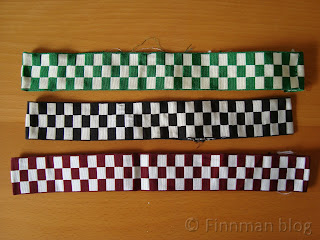 |
| A selection of peaked caps from different Police forces |
This section covers the peaked caps issued to male officers as well as bowlers issued to female officers in Avon & Somerset Constabulary.
There is some variation in the style of peaked cap used, according to rank. Constables and sergeants have a plain peak; Inspectors and Chief Inspectors have a black braided peak; Superintendents and Chief Superintendents have a silver braided peak; Assistant and Deputy Chief Constables have an oak leaf braided peak and the Chief Constable has a double oak leaf braided peak. Female officers follow the same system for their bowlers. Traffic officers use a white top version of the peaked cap.
Traditionally, constables and sergeants used plain chrome badges and ranks above had a coloured enamel badge. From the 1990's all ranks were issued with a coloured badge. Finding a genuine Avon & Somerset Constabulary issued peaked cap can be difficult. Most of those I've come across on eBay are not genuine. This can be determined by the combination of cap badge and type/style of cap.
1970's
The now iconic 'diced' or 'checked' police cap band was first used in Scotland. It was slowly adopted by Police Forces in England from the early 1970's. Newcastle were already using it in 1969 and Warwickshire Police from 1970. A Home Office uniform review recommended all Police in England and Wales should adopt them and they became standard issue from 1 April 1974.
The now familiar checked/diced band was introduced for peaked caps by Somerset & Bath Constabulary in 1972. Former Bristol Constabulary officers did not receive theirs until they became part of Avon & Somerset Constabulary in 1974. Avon & Somerset Special Constables were not issued with checked bands for several more years, around 1976. Caps have remained unchanged since then.
When Avon & Somerset was formed in 1974 it was typical for the cap badge to be mounted above the checked band as shown below. The early cap badges had a slider fitting which made fitting to the top part of the cap easier and more secure.
 |
| 1970's peaked cap |
1980's
From the 1980's badges were attached to the checked band by two double prongs on the cap badge
 |
| 1980's issue peaked cap. |
 |
| 1980's |
 |
| 1980's |
This 1980's example is fitted with a chin strap which is folded back inside the cap when not used. The black label seen on the liner at the back shows the size but there's no other makers mark. The brown sweatband is made of vinyl. Green has traditionally been the colour used on the inside of the peak. This liner is typical of those used by Avon & Somerset Constabulary in the 1980's.
Here's another example of a 1980's era peaked cap:
 |
| 1970's/1980's WPC hat |
 |
| Avon & Somerset WPC in 1979 |
Notice on the photograph here that the black backing which the cap badge is mounted on, is behind the checked band. The London Met Police usually had theirs mounted on top of the checked band. At the same time as the new style ABS custodian helmet was introduced in 1980, female officers were issued with their ABS 'bowlers' which replaced the white top hat seen above. The new bowlers were black, with the exception of the Traffic department which had a vinyl white top.
1990's
During the 1990's a coloured cap badge was introduced with a single brass screw fixing.
 |
| Current issue peaked cap |
 |
| Current issue bowler |
Traffic division caps
 |
| 1980's Traffic Division peaked cap |
 |
| Current issue Traffic Division peaked cap |
 |
| 1990's female officer's Traffic Division bowler |
The bowler shown above still had a piece of packing tape around the inside of the sweatband. This was sometimes used by Traffic officers to gain entry into some older types of cars. It could be used to slide inside the edge of the door and pull up the old style door locks.
Senior Officer's caps
 |
| Inspector/Chief Inspector peaked cap |
 |
| Inspector/Chief Inspector bowler |
 |
| Superintendent/Chief Superintendent peaked cap |
 |
| Superintendent/Chief Superintendent bowler |
 |
| Assistant/Deputy Chief Constable cap with oak leaf braiding |
The Assistant/Deputy Chief Constable peaked cap shown above is unusual in that it does not use a metal cap badge or checked band. Avon & Somerset Constabulary have adopted a 'bullion' style cap badge for the most senior ranks as also seen in the photographs below. Any Avon & Somerset oak leaf peaked caps with a metal style badge may not be genuine.
 |
| Avon & Somerset Constabulary ACC c.1980's wearing the same style cap as shown above |
This next photograph of Assistant Chief Constable Malcolm Popperwell from 1986 is intereresting in that he has the oak leaf peaked cap but with a metal cap badge. This demonstrates how there could be slight variations in uniform standards at different times at all levels.
 |
| Assistant Chief Constable Malcolm Popperwell 1986 |
 |
| Assistant Chief Constable Steve Mortimore |
 |
| Former Chief Constable Colin Port |
 |
| Current issue PCSO bowler |
 |
| Current issue PCSO peaked cap |
Police Community Support Officers were first introduced in 2002. Avon & Somerset PCSOs appointed to traffic duties use caps and bowlers which have a blue band with a reflective white middle as shown below.
With peaked caps, the badge is mounted onto the band itself. In the case of the female issue bowler, the cap badge is mounted using a hole drilled through the ABS shell, just above the band (see photo below).
These next photographs illustrate the variation in hats issued to Bristol/Somerset/Bath female officers from the Edwardian period to the present time. Although female officers are usually issued with their own headgear, they occasionally wore the same peaked caps issued to their male colleagues.
1. Bristol Constabulary c.1920's
2. Bristol Constabulary c.1950's
3. Somerset & Bath Constabulary late 1960's/early 1970's
4. Somerset & Bath Constabulary early 1970's 'pillbox' style hat
5. Avon & Somerset Constabulary c. early 1980's
6. Avon & Somerset Constabulary c. 1990's ABS plastic bowler
Other headgear
For a short time from 1998 to 1999 berets were issued to dog handlers in Avon & Somerset Constabulary. Some Police Forces issued berets to firearms officers as shown below. Notice that the firearms officer in the photograph from the early 1990's is wearing a 1980's pattern anorak jacket. The new goretex versions were just being issued at this time.
 |
| A rare 1990's dog handlers beret |
 |
| City of London firearms officer c1993 |
In recent years baseball caps have made an appearance in most Police
forces. Initially used by firearms officers in black, the high visibility
version shown below has been used by both dog handlers and motorcycle traffic
officers with Avon & Somerset Constabulary. Black baseball caps are also used by for some duties.
 |
| Avon & Somerset Police issue high visibility baseball cap |
 |
| A future recruit trying out the baseball cap |
Cap bands
Police in Scotland were the first to adopt a form of checked band (also known as Sillitoe Tartan) on their peaked caps. Bands on peaked caps are used to distinguish different enforcement roles. The current Police checked cap band was already being used by Newcastle in 1969 and slowly spread throughout the country in the early 1970's. It became standard issue for all Police Forces in England and Wales from 1 April 1974. Only the Police can use a checked band which is black or navy blue.
The photograph below was taken during a Special Constables parade at Weston Super Mare in 1976. The senior officer on the far left has a checked band on his peaked cap which were issued in 1974.
The Special Constables on parade here have not yet had their checked cap bands issued, even two years after formation of Avon & Somerset Constabulary. A female officer can also be seen wearing one of the old style 'pillbox' hats, which had already been replaced by the white top versions for regular officers. It was common practice for Special Constables to be some of the last to receive uniform updates. Old stock would continue to be issued to Special Constables even though it was no longer used by regular officers.
Special Constables in the London Metropolitan Police were issued with their checked cap bands in 1978.
 |
| Special Constables parade, Weston Super Mare 1976 |
The photographs below are a selection of different cap bands used in different parts of the country. Whilst PCSOs generally use a dark blue band, some variation exist such as in North Yorkshire who use a checked blue and white band. Some Police forces including Avon & Somerset have re-introduced voluntary Police cadets. In Avon & Somerset they have a uniform with a light blue cap band. Other Police forces use a variety of colours including red and green for their cadets.
The first green and white example above is for the Royal Parks Constabulary. The middle black/white or navy blue/white is the standard version for Police Forces in England and Wales. I believe the brown and white example is for the old
Hammersmith & Fulham Parks Constabulary. Higher quality versions can sometimes be found on senior officer peaked caps. These have a slightly reflective woven texture whilst standard versions appear printed. The City of London Police use a red and white version.
 |
| 1. Police 2. Traffic Warden 3. PCSO (Met) |
More cap band comparisons:
1. Unknown, probably local authority Parking Enforcement Officer.
2. Traffic Warden North Yorkshire.
3. Unknown generic Traffic Warden - the holes for the cap badge are still visible.
4. PCSO North Yorkshire (see below).
5. PCSO Avon & Somerset reflective band (Traffic).
 |
| North Yorkshire PCSO with blue chequered hat band |
Cap covers
Rain covers were standard issue for use with the peaked cap. The white version would be used by Traffic officers who had the standard peaked cap before the vinyl top version became available.
 |
| Standard Police issue rain cover for peaked cap |
 |
| Rain cover for Traffic officers peaked cap |
 |
| Cotton version (dust cover?) probably not Police issue |
Buyers guide
How do I know if it's 'genuine'? Familiarity will help but it may not be possible to say for sure if the cap you buy has the badge which was originally fitted. For many years it was common for senior officers to be issued with blue enameled badges which were different to the standard version. Senior officers peaked caps are easily identified by the braiding on the peak. Therefore such a cap fitted with a standard badge could be an indication it has been changed. It's also possible for a badge to be changed in-service when a new design was issued.
There are plenty of police peaked caps available to buy on eBay. Many are sold by dealers who are adding badges themselves. Buying from a private seller means you can ask them if they know about it's history. Many retired police officers retained their headgear as a souvenir and the day may come when they decide to part with it. This is the best source for a collector.











































Interesting posts, changes in the police cap reflect changes in the times, and time gives these hats a special meaning.
ReplyDelete